

[12/19/2012 updates are in the Taskbar and Delete Confirmation sections and the two new screen shots of the Classic Start Button and the discussion of the Windows.old folder at the very end.]
I've gotten more than one phone call from friends who have just installed Windows 8. Their question is: "How do I turn it off?" The answer is the power button is on Settings menu which you get to from the Charms bar on the right. You can get there directly with the WinKey+I shortcut or via the shortcut for the Charms bar: WinKey+C. As you start to use Windows 8, be sure and print the first page of my list of Windows 8 Shortcuts. If you're using a keyboard and mouse they make your life much easier. See below for how to put a shortcut on the Start Screen and/or the Desktop for turning off the machine.
Setting the time zone no longer seems to be part of the installation process. Click on the clock on the Desktop, then "Change date and time settings". Set the time zone (on the first tab). Then on the Internet Time tab choose "Change Settings" and then "Update Now".
If you followed my advice and did a clean install there are two basic things you need to do first:
Now that you have some Windows 8 Apps and some Desktop Programs you're likely to use, you're ready to start organizing your Start Screen.
Put the Desktop button in the top left position. This allows you to get to the desktop by just pressing the Enter key from the Start Screen.
Move your Tiles around, organizing them into groups. (You can name the groups and move entire groups around.)
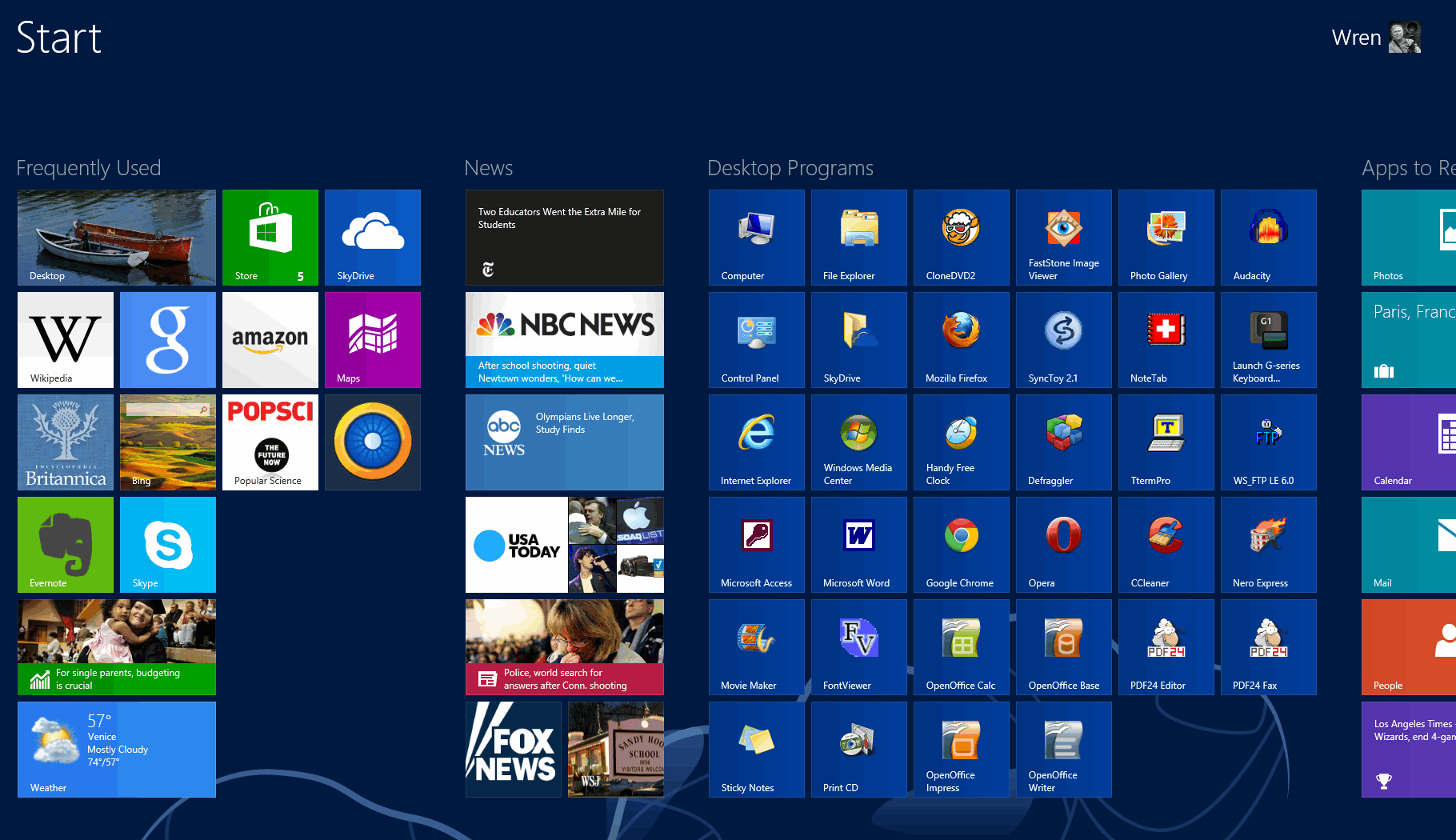
I currently have my Start Screen organized in these 5 groups:
Many people have written tutorials, or created videos on how to customize your Start Screen, so I won't go into the details here. Google "Windows 8 Start Screen Tutorials". My advice is to watch some of the videos, or here is just one article on Customizing the Start Screen.
If you see a number on the tile for the Store:
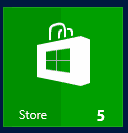
It means that many of your installed Windows 8 Apps need updating. Click on the tile, and then in the upper-right corner click on Updates:

You'll see an updates screen like this:
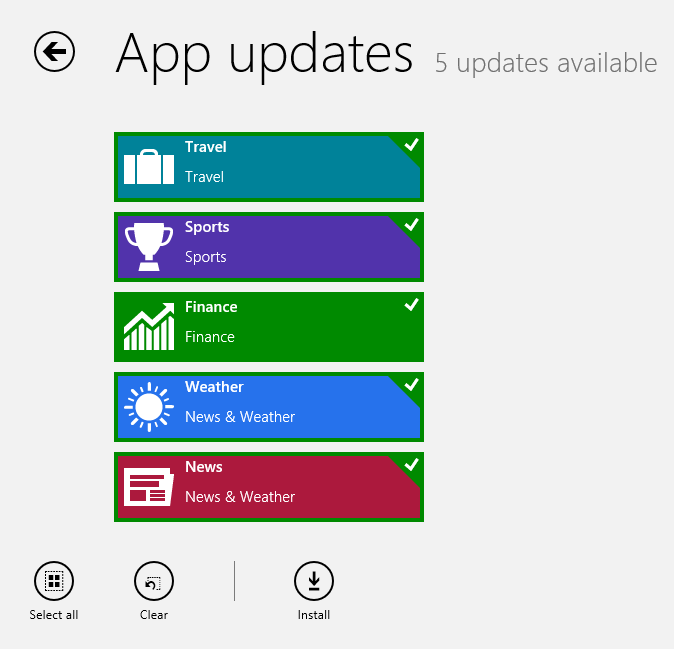
They're probably all selected, if not press on the Select All button, or choose just the ones you want to update. Then press Install and you'll see something like this:
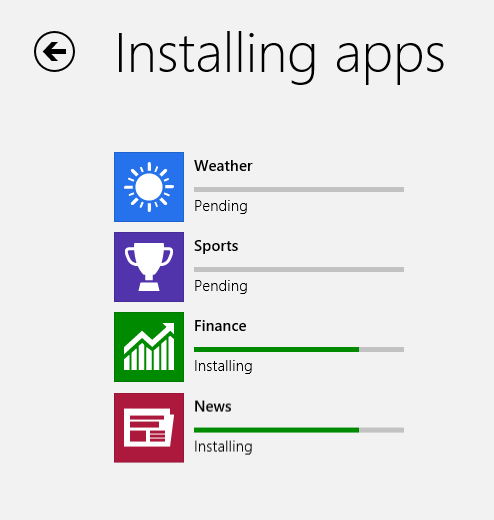
Unless I'm using a touch screen, I find myself mostly working on what Windows 8 calls the Desktop. My first solution to the lack recent program choices on a Smart Start Button was to put all the programs I use frequently on the Taskbar. This way they are always accessible with a single click.
Now I've come to love the Classic Shell Start Button (see below) so now my Taskbar has basically the same program pinned to it that my Windows 7 machine had.
Tip: Be sure the first nine programs pinned to the Taskbar are the same on all your machines. Both Windows 7 and Windows 8 machines. This will allow to use the same WinKey+# shortcuts on both. See Windows 8 Shortcuts. For example, my Taskbar currently looks like:
![]()
If I press 7 while holding down the WinKey it starts the Calculator I use. This is because, not counting the (Classic Shell) Start Button the Calculator is the 7th program (counting from the left) pinned to the Taskbar.
Speaking of the Taskbar, I usually prefer to open Windows (File) Explorer with the "Computer" view instead of the Library view. You can do this with the WinKey+E shortcut, but I also like having a shortcut on my Taskbar that does this. Download this Computer Shortcut in a ZIP file, put it somewhere and then unzip the shortcut on your desktop; then pin it to the Taskbar. On my Taskbar (above) it's the icon between the one that looks like a folder (Windows Explorer, Library View) and one with a triangle in an orange circle (Media Player). You'll never see it highlighted (showing it's running), instead each time you press it you'll see the folder (Windows Explorer icon) highlighted again.
In Windows 8 when you delete all the files and/or folders currently selected it no longer asks you if you're sure you really want to do that. While many think this is an improvement, personally I find it too easy to hit the Delete key by mistake and like the confirmation. If you want to turn the confirmation back on, right-click on the recycle bin and choose Properties. You'll see this dialog:
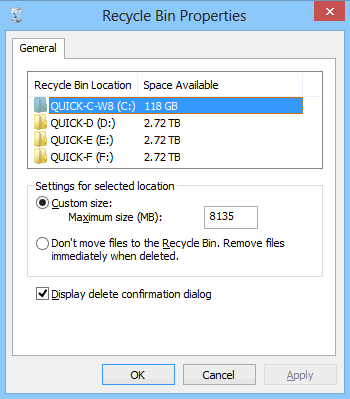
Check the box at the bottom to "Display delete confirmation dialog".
[Update: If you install the "Classic Shell Start Button" (below) you really don't need either of these buttons. You can skip to that section.]
I assume Microsoft is going to soon give you the option of putting a Start button back on the left side of the Task Bar that gives you the old "Smart Start Menu" ... it was called "smart" because what appeared on it were the programs you used recently ... you didn't have to configure it yourself like you do the tiles on the Windows 8 Start Screen (although you could pin programs to the top of it and reorder by dragging around).
Now to get to the Start Screen with a mouse you have to hover in the bottom left and wait for the Start Screen icon to appear ... I've found this a bit of a pain, because it's easy to click on whatever the first icon on your task bar is instead. Somewhere on the internet (I need to remember where and give them credit) I found two mini programs, one put a dumb start button back on the task bar (clicking on it just gets to the Start Screen, but you don't have to hover and wait. The other gives you an power button you can put on the desktop or on the task bar (you have to verify you want to actually shutdown or you can pick another option, like restart, so you don't turn off the machine by accident.
These buttons look like this:
![]()
To put them on your machine you download two programs (below), put them in a folder (I recommend the Program Files, or Windows folder, both of which make sense but you have to answer more stupid questions to put them there), and then create shortcuts to them via the old standard: right-click on the program and choose the "Send to ..." option and then "Desktop (create icon)" from the pull-down. Once they're on the desktop you can drag the "Start" shortcut to the first position on the Task Bar (and then either delete it from the desktop of hide it in a folder with other shortcuts to programs). Once you have a shortcut to the Shutdown program on your desktop, you can right-click on it and choose: "Pin to Start" (and then move it to one the appropriate group). I just left the Shutdown button on the Desktop, but you can also put it on the Task Bar, the Programs folder, or delete it if you want.
Here are the programs to download: Start.exe and Shutdown.exe. Put them somewhere in a folder that makes sense to you (Windows folder, Program Files, etc.) and then create shortcuts to them (see above).
Here's a free program you can download and get back the features of the Windows 7 start button plus some new ones:
https://sourceforge.net/projects/classicshell/
After installing (you may not want to install everything included in the package, see below), when you press the new Start button which appears on your Taskbar you see something like:
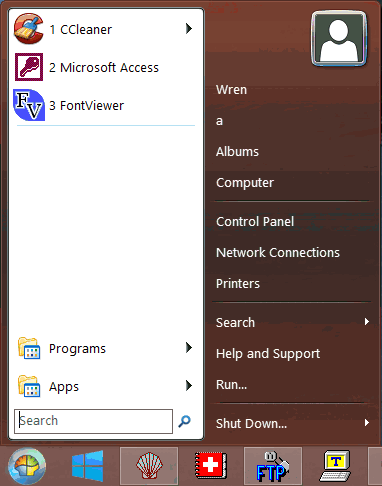
In addition to recently used programs you see "Apps" which allows direct access to any of the Windows 8 Apps you've installed. In the right hand column you will have access to "Documents" (which I've renamed "a" on my computer) and "Pictures" (which I've renamed "Albums").
Note the faint blue line across the left column (below FontViewer). If you drag a program from above the line to below it you "pin" it to this menu (remove the one left above the line by right-clicking and "Removing from this list"). On the Windows 7 Start Menu, the pinned programs were on top, instead of at the bottom. Actually this makes the most sense ... the programs you JUST used are always at the top.
When you install it, unless you later find you need them, I recommend NOT installing the "Classic Explorer" and "Classic IE9" options:
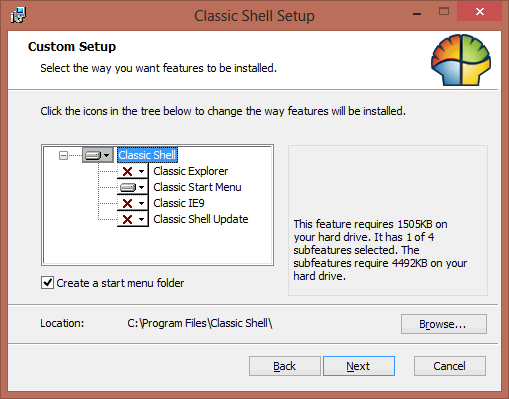
When you see the screen above, use the pull-downs to put red Xs next to those options. You may want to install the Update option, I didn't but probably should have.
After installing be sure to right-click and choose "Settings". I didn't like the defaults at all. On the Start Menu Style tab choose "Vista/Windows 7":
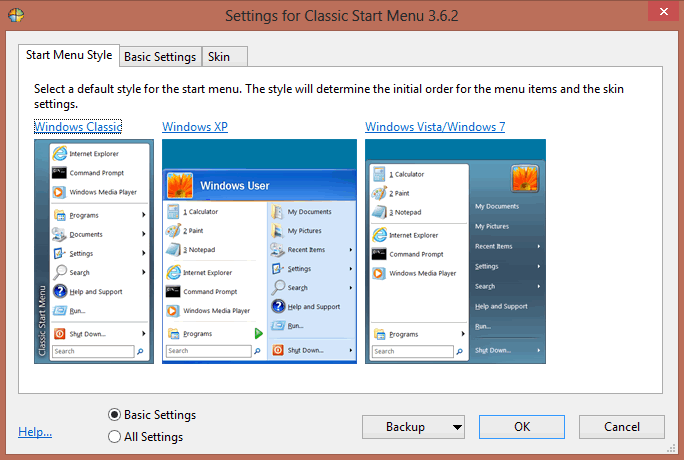
The items I changed on the Basic Settings tab are shown below in bold. I changed what the Win Key does because I've come to like the new Windows 8 Start Screen and a few of the (not) Metro Apps on it. You also might want to turn on "Show Recent Programs" on either this tab or the "Special Items" tab (below). It is suppose to be the default, but for some reason it wasn't when I installed:
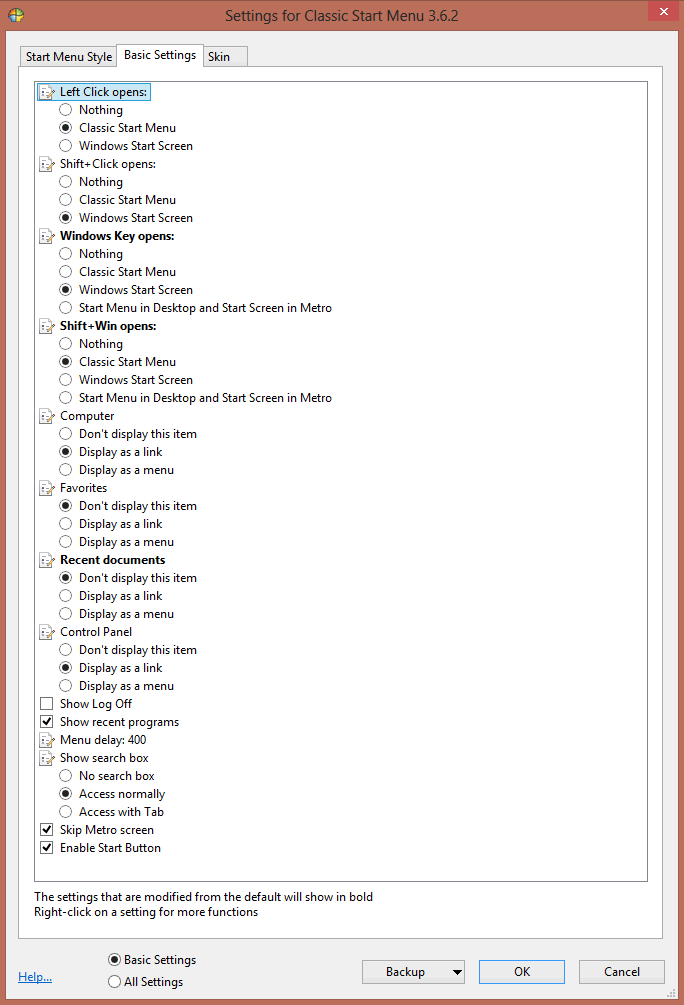
I think the "Windows Aero" skin was automatically chosen when I picked the Window 7 style, therefore, I didn't made any changes on this tab, but you might want to:
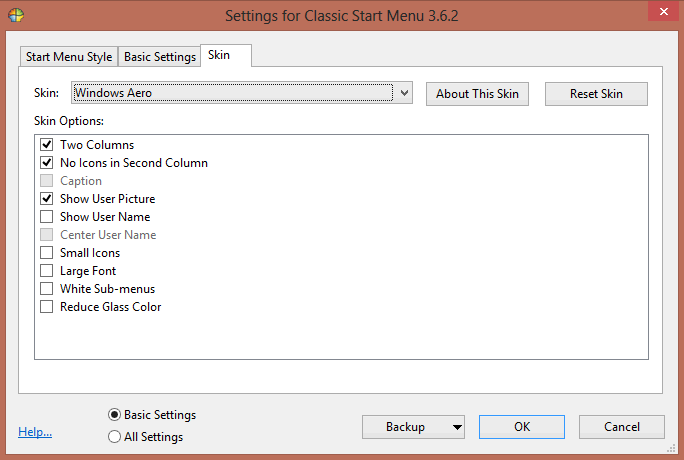
If you click on the "All Settings" radio button, a lot more tabs appear. I haven't explored them all. You might want to make changes on the Windows 8 tab, by default it deactivates the bottom left corner and I decided to turn it back on. Later I decided to turn if back off:

For some reason after I installed this program no programs were showing up on the top left side of the new start menu. Here I checked both "Show recent programs" (which is suppose to be the default) and I increased the "Max recent programs" number. On my monitor I can even increase it more than the 20 shown here:
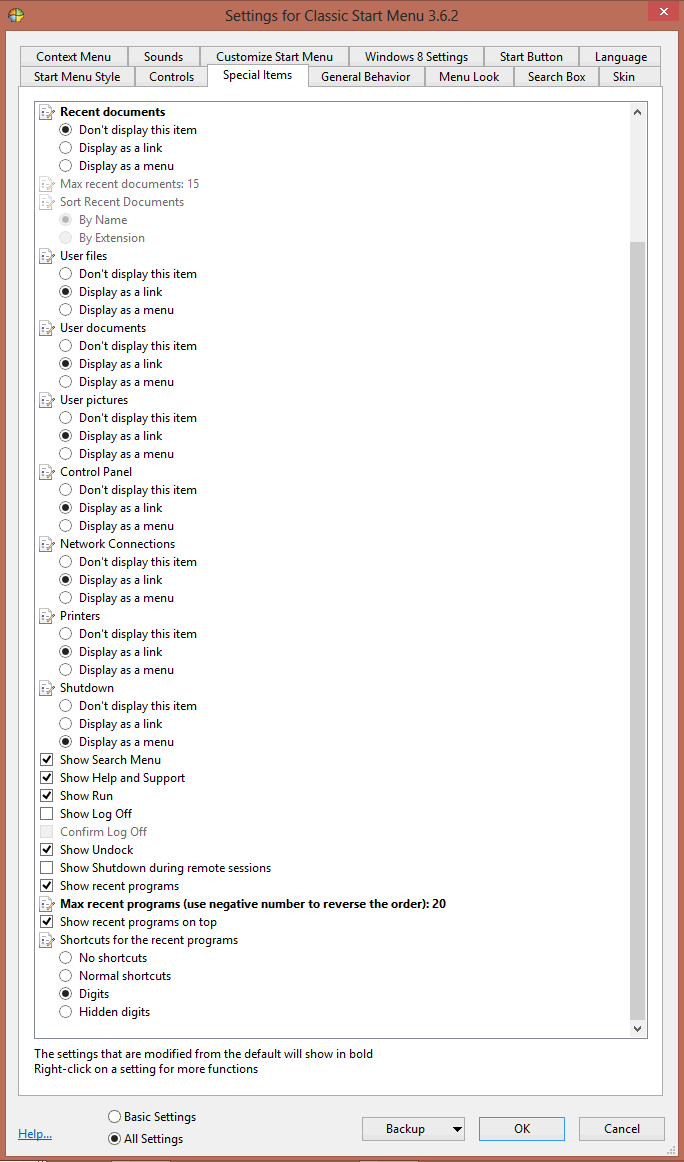
I have no idea what the "Digits" choice (the default) is ... I'll let you know if I figure it out. [Update: Digits is the number that appears, before recently used programs at the top of the left column. A better choice is probably "Hidden digits" which will hide these numbers.]
I also changed the icon for the Start Button to the "Metro" style (Start Button tab in settings, under Button Look). [8/2013: This option has been removed at Microsoft's request, see www.classicshell.net/forum/viewtopic.php?f=18&t=802 for info on how to download specify as an alternative Start Button.] Here's what it now looks like when I press this Start Button:
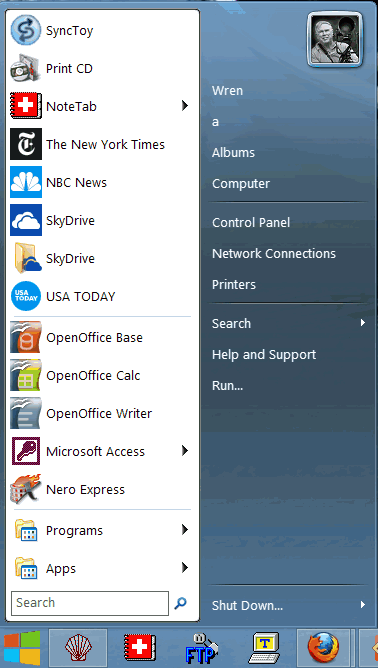
(Actually the Start Button is all blue until I press it, then it becomes multi-colored.) Recently used programs are at the top and the MOST recently used (SyncToy) is at the very top. Programs I've pinned to this start menu are between the two thin blue lines: OpenOffice Base, Calc and Writer, Microsoft Access and Nero Express. Below that are flyouts giving you access to all Programs and all Windows 8 Apps (notice that several of the recently used programs are Windows 8 Apps which I started from this list of Apps (they only appear if you start them here, and not from the Windows 8 Start Screen). You'll also notice that the Metro style Start Button icon I've chosen turns from blue (see above under Taskbar) to multi-colored when the start menu is displayed.
On the various settings tabs for the Classic Start Button you can control what appears in right column. You'll also notice certain items in both columns have little arrows indicating flyouts. For the programs these allow direct access to recently used files (the same as jumplists that appear when you right-click on icons on the Taskbar. Here's an example of what the flyout looks like for the NoteTab (file editing) program:
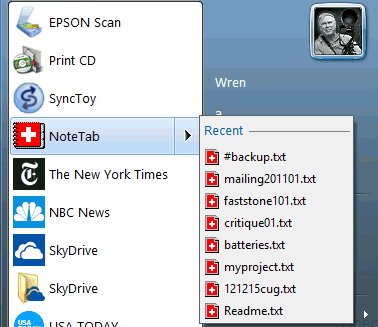
If you do the install in the existing partation (instead of an empty partition as I recommend) you're going to endup with both Windows 8 on your hard drive and your old version of Windows in a folder with a name like Windows.old ... as far as I know you don't need this, but you probably can't just delete it. See this discussion of deleting Windows.old folder. Option one, using Disk Cleanup looks pretty easy.
Suggested next choices: